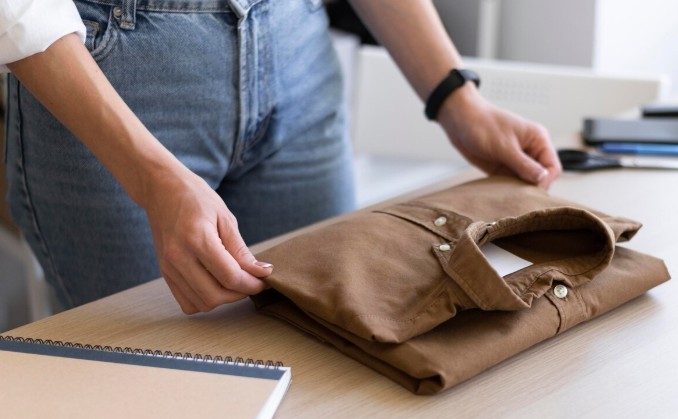Have you ever picked up a shirt with a nice design on the front, only for it to wear off or tear after a few months of wear? It’s an experience nobody appreciates–especially your future clients. When you’re building an apparel brand, you want your name to be associated with top-quality designs and materials. So how can you tell the good and the bad apart when purchasing fabrics from your manufacturer? Not to worry–there are a few key indicators in how to recognize great fabric quality, just from a single touch.
Most good designers are able to recognize these elements from the get-go, which is why fabric sampling is so important in merchandising. Some people may think the best solution is to look at the price, but in today’s world, there are plenty of manufacturers and retailers looking to dupe people into buying lackluster polyester for a fortune.
If you want to keep your clients happy and avoid purchasing cheap materials for much more than their worth, check for the following elements:
- Material & Texture

We’ve talked briefly about how more synthetic materials are associated with cheap, listless clothes, but recognizing it is a different matter. Nowadays, over 70% of clothes are mixed with polyester to some extent, sometimes mixed with other fabrics. This isn’t necessarily bad, as some of these materials are made to feel better on the skin, but it’s always important to check the overall effect first for great fabric quality.
If you want to feel whether a fabric is up to standard, perform a brief test to feel the following:
- Surface: Is the fabric rough or delicate? The softer and smoother it is, the better it tends to be.
- Hardness: Is the fabric stiff? Does it wrinkle or crease easily when squished? Good quality fabrics tend to keep their shape and avoid wrinkles after a bit of pressure.
- Softness: How does the fabric feel on the skin? You’d prefer something softer and gentler when building fabrics, and warmer textures can also help if you’re selling to clients in colder temperatures.
2. Durability
Durability discusses how resilient fabrics are against the stresses of everyday life. This one takes more time to test out, but if you have a sample of the fabric, you can stretch or press against it to induce a similar effect.
A highly durable fabric will be able to keep its original composition under duress. This means that the stitches won’t tear, the fabric itself won’t rip or bend, and the initial colors won’t wash off over time. This can be seen quite easily after a quick spin in a washing machine or at the dryers, as great fabric quality will last longer in these cycles.
Meanwhile, lower-quality fabric will often follow stretches or tears within just a few months. This is often the result of cheaper quality fabrics, which ends up being more expensive for the client over time as they need to replace their subpar products.
If you’re not able to test a fabric from your manufacturer, you can check if they have a GSM list for their various fabrics. GSM stands for Grams per Square Meter, and it tells you how thick a fabric is. Higher GSM materials will often be more dense and reliable over time, like many of Shirtual’s own offerings. Ideally, you’d want something above 150 GSM to keep your fabrics durable, unless you’re making summer or heat-repellent apparel.
3. Comfort

The biggest factor in considering how much a fabric is worth is how comfortable it is when worn. Does the fabric allow air to flow in and out of the threads, giving a more breathable and weightless feeling? Is it easy on the skin, or does it stick too much or feel too coarse? Does it fall elegantly down when hung, or does it bunch up and cause issues for wearers?
You’ll also notice that lower-quality fabrics have more issues in the long run. Some of them ‘pile up,’ or produce balls of lint or threads made from overuse. Clients will later have to clean these lint balls using combs or specialized tools, which will either eat up more time or force them to use disheveled-looking clothes.
The fabric alone isn’t necessarily all that’s going to decide the comfort level of apparel, but it is a significant factor. If you have fabric that’s easy to work with, the sewing and design process ends up being much simpler and more affordable in the long run. Purchasing great fabric quality is ultimately less a cost and more a future-investment for you and your clients.
4. Weaving threads
How a fabric is woven and stitched plays a good part in its durability and comfort. Some manufacturers will offer a thread count or the number of threads you can find in their fabric per square inch. If this number is high (i.e. above 350) you’ll find that there’s more patterns on the surface, thus adding to the material’s strength over time.
If you can’t find the thread count, you can also check the fabric by putting it close to light and stretching. Thinner fabrics will let more light pierce through, and you’ll be able to see more of the holes in between threads.
While you’re doing this, you should also pay attention to the patterns of the threads. Is it woven equally, or are there a few spaces with patches or gaps? This informs you of the quality of the manufacturer’s sewing, as well. Great fabric quality comes with tighter weaving and fewer holes in between threads.
5. Sources

This one isn’t necessarily something you can touch, but it is something that you can immediately inquire from the manufacturer. Knowing where your manufacturer gets their fabrics is essential, especially if you’re courting sustainability-minded clients. Finding manufacturers that source from SFC-accredited textile partners or other certifications for quality will help you find out which is best to work with.
You can also do a little research on the reputation of a manufacturing brand before purchasing their fabrics. Merchandise services that have an international reach and multiple awards will be more reliable compared to others. Shirtual’s own services have produced merchandise in over 85 countries in just half a decade, with more than ten awards to date. Be sure to choose from reliable sources when searching for partners in your new apparel endeavors.






